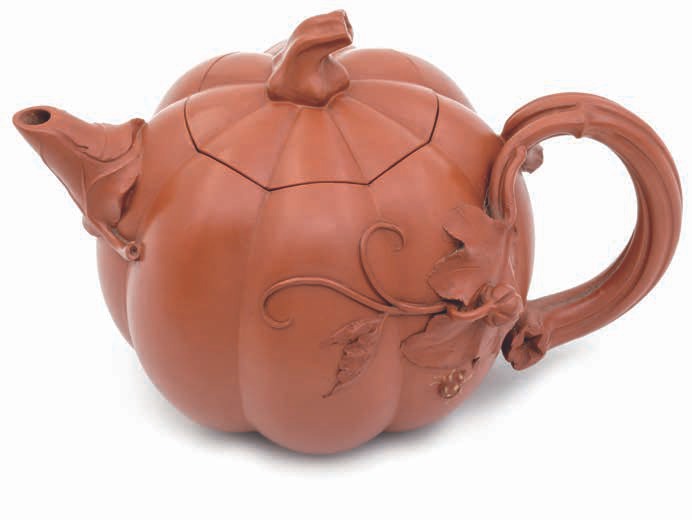
 |
|
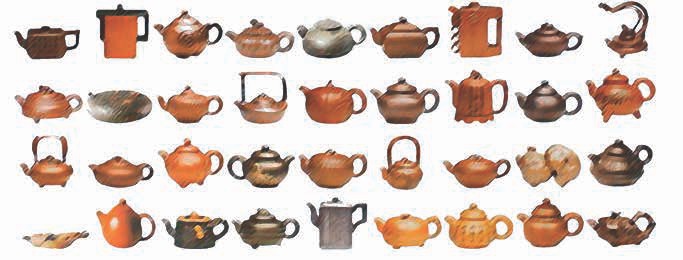
If you include all the artistic pieces and nuances of classical shapes, there are literally thousands of kinds of Yixing pots! Each of the classical styles has been adapted and creatively sculpted into subtle shades of the original, creating a vast array of shapes within each "shape." The classical styles can therefore be thought of as families of pots, since students learn by first replicating the masters of old, then adapting the old masters' pots and finally creating their own masterpieces, which will be studied down through the ages.
One of the wonderful aspects of Asian art that we appreciate is the fact that for centuries masters created beautiful works of art without any need to attach their names to the pieces. Instead, they would honor their heritage by stamping the names of past masters, especially when the piece they were making was an homage to something created by that master. This trend was certainly informed by Tea, as so many craftsmen in Asia made teaware as part of their craft or art, if not exclusively so. It is in the spirit of tea to be humble and to not desire any fame or credit for one's service. In our tradition, we always say that we aren't here to learn to make tea, but rather to serve Tea. And the "serve Tea" here can have several meanings. Of course, this means to prepare bowls or cups of tea and share them with people, but it also means to serve Tea Herself, the Nature spirit within these leaves. Even in biological terms, we are symbiotic with Tea, as we not only promote the propagation of her offspring, but also teach people to care for the trees in a way that promotes their health and happiness. Serving this healing medicine, and the changes it can facilitate in the human-Nature relationship, is a very ancient practice. And it is out of such service that the need for reward or accreditation was dropped by simple Chajin stamping the names of their masters' masters onto the bottom of pots. Their reward was in the making of the pot. Wonderfully, this tradition continues today in Yixing, though more of the younger generations of craftspeople are ambitious to make a name for themselves.
There are five basic categories for the styles of Yixing pots, though various authors categorize the styles of pots in different ways. It really is up to each collector to organize his or her own pots. We have chosen these five to simplify things, and have done our best to present you with at least one pot from each of the five categories. As you will see, all our pots are used, stained by spring water, good tea and hours of joy.
There are also three ways of making Yixing pots: handmade, half-handmade and cast. From lowest to highest, the cast pots are made from soft clay that is formed by machines in full-body molds, and then dried and trimmed before firing. Half-handmade pots are made with molds. The body and lid are pressed by hand into the molds and the handle and spout are often made by hand. The pieces are then assembled, trimmed and polished by hand as well. (This is how the lowest-grade student pots at Master Zhou's are made.) These pots actually still require a lot of skill to produce and each one can take two to three full workdays to complete, though apprentices often work on several at once. This is the way most students learn to make pots. Finally, fully-handmade pots are crafted in the age-old way: slapping, pounding and shaping each part by hand. Such pots can take days, weeks or even months to complete! Yixing pots are not thrown on wheels, but rather "slab-built," which means sculpted.
When choosing a teapot, one can try to learn about its provenance. Many collectors start their study of Yixing by learning to recognize some of the chop marks on the bottoms of the teapots. The chop will either be the name of the artist, or perhaps the factory itself in the case of mass-produced or handicraft pieces. Nonetheless, in the beginning it helps to have a teacher to guide our purchases. Most times anyone can distinguish the mass-produced pieces from the other categories, though the discrepancies between the finer groups are more difficult to discern. Still, even mass-produced pieces aren't necessarily undesirable, depending on one's preference of style and budget. It is important, however, for the consumer to know what it is they are buying. For that reason, it's better to buy from a vendor with a good reputation and more transparent product information. Without any help, it's best to just handle the pot for a while and use one's senses to assess its artistic quality and function. It should have a fine form and structure, with nice proportions between the spout, handle, lid and bottom. The skill of the craftsmanship should be apparent from sight and touch alone. Of course, the price and personal perspective will also play a part in the selection. It should be functional and suit the needs of the user with regards to volume, kind of tea and aesthetic representation.
There is an artistic and a functional standard for evaluating Yixing teapots. Artistically, it is important that the pot be well-formed and appeasing aesthetically. It should refine the tea ceremony by appearance alone. Beautiful pots add to the ambience of tea and lend elegance to an otherwise mundane activity. There are four levels of craftsmanship that we use to discuss Yixing pottery: Mass-Produced Pieces, Handicraft Ware, Special Artistic Pieces and Master Artistry.
Over the next few pages, we would like to show you some of the classical styles of teapot we enjoy. As we are tea-brewers, our proclivity is for shapes and styles that make nice tea. That said, we have tried to present you with what are some of the most famous styles of pots, and to show you some that are more artistic than utilitarian. For us, however, the best styles of pots are always the ones that look gorgeous, are balanced and harmonious throughout, and also make great tea - which means they pour well, are made of nice clay and have a design that is nice to hold in the hand. Each of these styles of pot is really a family, with many subtle variations. Over time, as you learn about Yixing pots, you will begin to recognize the more famous shapes, even if they are adapted slightly. Compare your pots to the shapes shown over the next few pages and show us some of the variations in your collection on the app!
 Called "Balances in Water," as these pots are
supposed to float if they are made perfectly.
These are probably the most produced pots
in history, made extensively throughout the
Republic (1911 - 1949) and Communist eras
(post-1949).
Called "Balances in Water," as these pots are
supposed to float if they are made perfectly.
These are probably the most produced pots
in history, made extensively throughout the
Republic (1911 - 1949) and Communist eras
(post-1949). These "Chopped Ball" teapots are named this
because it is supposed to be made from the
slices of a perfect orb, cut up and rearranged
with skill in various shapes and styles. This
style began in the mid-Qing Dynasty, which
lasted from 1644 to 1911.
These "Chopped Ball" teapots are named this
because it is supposed to be made from the
slices of a perfect orb, cut up and rearranged
with skill in various shapes and styles. This
style began in the mid-Qing Dynasty, which
lasted from 1644 to 1911.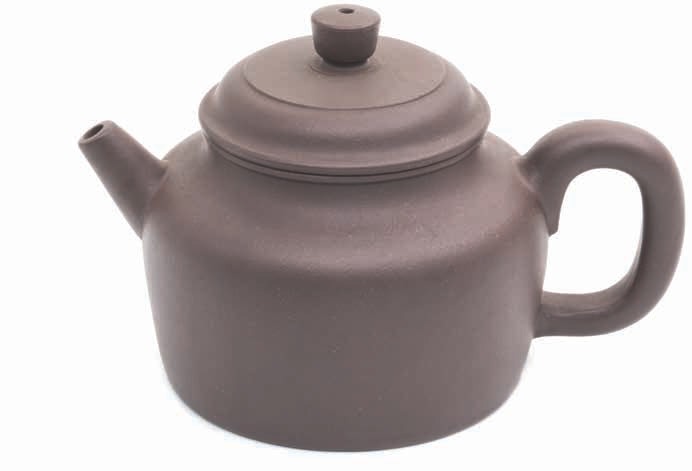

 "Straight Scoop" teapots are styled after other scoop-shaped pots and also
influenced by
pear-shaped pots, of which there are many.
This is a great shape for beginners, as it is
useful for all kinds of tea. These pots are also
known as "Guava pots (芭樂壺)."
"Straight Scoop" teapots are styled after other scoop-shaped pots and also
influenced by
pear-shaped pots, of which there are many.
This is a great shape for beginners, as it is
useful for all kinds of tea. These pots are also
known as "Guava pots (芭樂壺)." This is a specific kind of pear-shaped pot that
has been famous for centuries. They are often inscribed "思亭" on the bottom.
The long,
elegant spout means less room to choose the
speed and distance of the pour when decanting, but they sure are gorgeous!
This is a specific kind of pear-shaped pot that
has been famous for centuries. They are often inscribed "思亭" on the bottom.
The long,
elegant spout means less room to choose the
speed and distance of the pour when decanting, but they sure are gorgeous!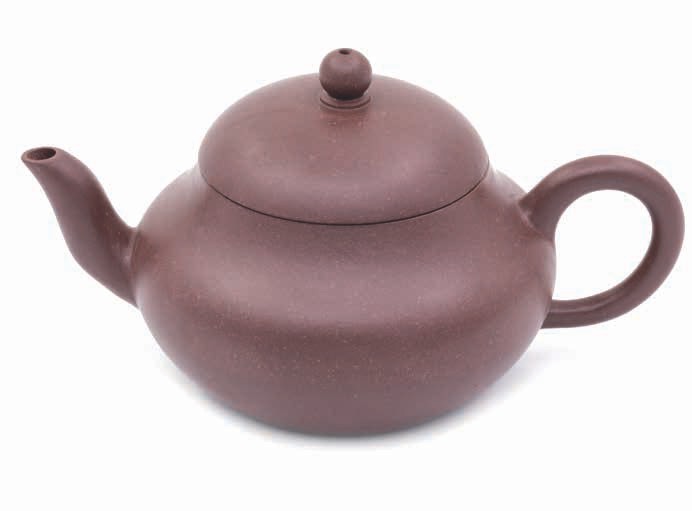
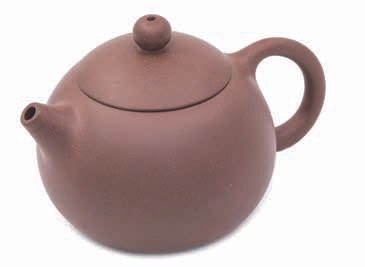 Shi Yiguang (施夷光) is one of the "Four
Great Beauties" of China. She is said to have
been so beautiful that fish in her pond would
gaze at her and forget to swim. This style of
pot is designed to resemble her breast. Also,
the handle is upside-down.
Shi Yiguang (施夷光) is one of the "Four
Great Beauties" of China. She is said to have
been so beautiful that fish in her pond would
gaze at her and forget to swim. This style of
pot is designed to resemble her breast. Also,
the handle is upside-down. These famous pots date to the middle of the
Qing Dynasty (1644 - 1911). Many variations
of this style exist. The name is a bit cheeky, as
it refers to the shape of the spout. (Someone obviously had a strong sense
of humor.) They are
wonderful pots for tea.
These famous pots date to the middle of the
Qing Dynasty (1644 - 1911). Many variations
of this style exist. The name is a bit cheeky, as
it refers to the shape of the spout. (Someone obviously had a strong sense
of humor.) They are
wonderful pots for tea.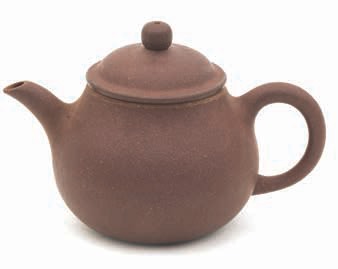 This is an "arhat" teapot. Arhats are Buddhist
saints. The pot is said to resemble a saint seated in meditation,
especially if you cover the
handle and spout. These pots date back to the
Ming Dynasty and are one of our all-time favorite pots.
This is an "arhat" teapot. Arhats are Buddhist
saints. The pot is said to resemble a saint seated in meditation,
especially if you cover the
handle and spout. These pots date back to the
Ming Dynasty and are one of our all-time favorite pots.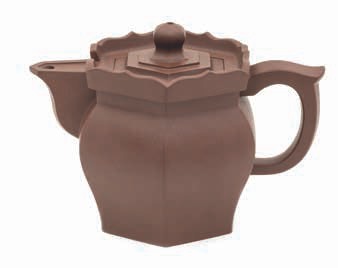 "Monk's Hat" teapots are said to resemble a
sacred hat of the time. This style was created
by one of the earliest and greatest Yixing masters, Shi Da Bin (時大彬). They
aren't easy
to shower, so they aren't great for all tea, but
they do make nice red tea.
"Monk's Hat" teapots are said to resemble a
sacred hat of the time. This style was created
by one of the earliest and greatest Yixing masters, Shi Da Bin (時大彬). They
aren't easy
to shower, so they aren't great for all tea, but
they do make nice red tea.
 Shi Piao teapots are named after ladles used
in wells. These pots, like many other styles,
are celebrations of Quotidian Treasures, the
honoring of the ordinary. This shape of pot
is great for young sheng puerh, or for serving
many guests.
Shi Piao teapots are named after ladles used
in wells. These pots, like many other styles,
are celebrations of Quotidian Treasures, the
honoring of the ordinary. This shape of pot
is great for young sheng puerh, or for serving
many guests.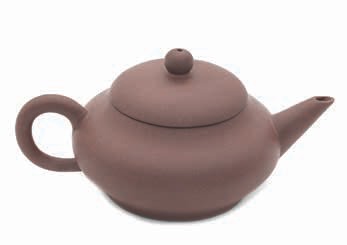 These common pots have been made in many
styles over the centuries. They are often adorned
with engravings or carvings to highlight their
royal flair. This simple version is made of a decent
grade of clay and is good for striped oolong teas,
like Dancong or Cliff Tea.
These common pots have been made in many
styles over the centuries. They are often adorned
with engravings or carvings to highlight their
royal flair. This simple version is made of a decent
grade of clay and is good for striped oolong teas,
like Dancong or Cliff Tea.
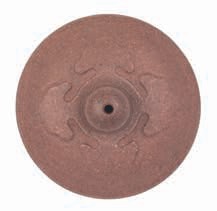
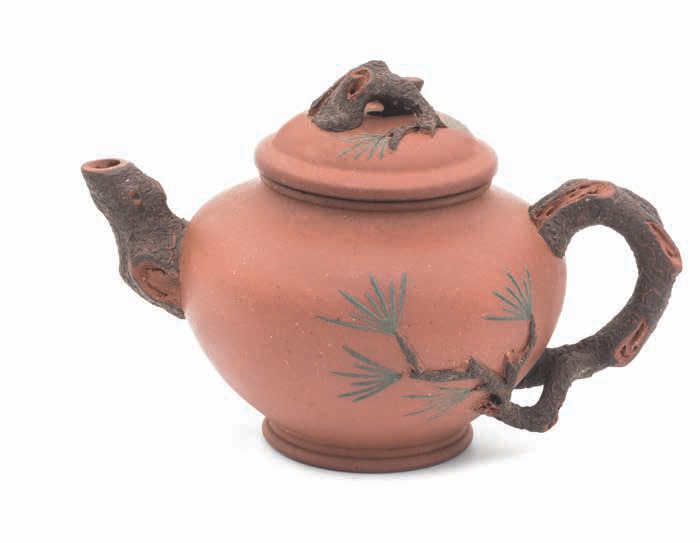
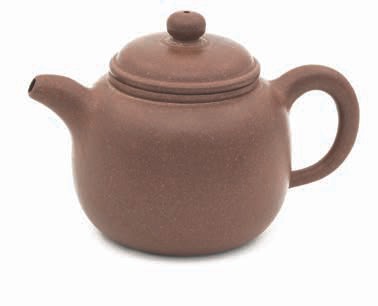 This is one of our favorite pots for making tea.
This shape makes excellent shou puerh and
red tea. The tall, thick walls preserve the heat
better than many shapes, producing a thicker
and more delicious liquor.
This is one of our favorite pots for making tea.
This shape makes excellent shou puerh and
red tea. The tall, thick walls preserve the heat
better than many shapes, producing a thicker
and more delicious liquor.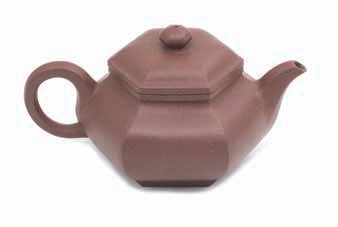
 This pot is thus named because "cang" is a homophone with "cang (same word,
different sound),"
which is when turtles retreat into their shell, which
the pot resembles. Turtles hiding in their shells is
an old Zen metaphor for meditation.
This pot is thus named because "cang" is a homophone with "cang (same word,
different sound),"
which is when turtles retreat into their shell, which
the pot resembles. Turtles hiding in their shells is
an old Zen metaphor for meditation.
 Chen Man Sheng (陳曼生) read "The Book of
Han," from the Han Dynasty (206 BCE - 220 CE).
Inside was one story about an official named Ji An
(汲黯), who spoke honestly and bluntly to the emperor, demonstrating
integrity that was rare in
those days. There was an old saying regarding Ji An,
"Straight like Ji (汲黯方直)." Inspired by this story,
and the uprightness of this ancient noble, Master
Chen created this pot. This amazing pot is straight
and tall, representing the uprightness of a noble
man. These pots can be rare, but if you search, you
can find versions of them. They are excellent for preparing red tea, as the
tall and thick walls allow for
longer steeps, creating a bright and sweet liquor, especially when brewing
gongfu red teas.
Chen Man Sheng (陳曼生) read "The Book of
Han," from the Han Dynasty (206 BCE - 220 CE).
Inside was one story about an official named Ji An
(汲黯), who spoke honestly and bluntly to the emperor, demonstrating
integrity that was rare in
those days. There was an old saying regarding Ji An,
"Straight like Ji (汲黯方直)." Inspired by this story,
and the uprightness of this ancient noble, Master
Chen created this pot. This amazing pot is straight
and tall, representing the uprightness of a noble
man. These pots can be rare, but if you search, you
can find versions of them. They are excellent for preparing red tea, as the
tall and thick walls allow for
longer steeps, creating a bright and sweet liquor, especially when brewing
gongfu red teas.
 This is amongst our all-time favorite teapot shapes,
reminiscent of a mountain spring bubbling to the
surface and cascading down in clear and pure pools.
It is inviting to hold, touch and use to prepare tea.
The button even resembles the center of the crystal
spring pool where the water rises from.
This is amongst our all-time favorite teapot shapes,
reminiscent of a mountain spring bubbling to the
surface and cascading down in clear and pure pools.
It is inviting to hold, touch and use to prepare tea.
The button even resembles the center of the crystal
spring pool where the water rises from. This pot was also created by the great Shi Da
Bin. It is based on the bronze works of the
Han Dynasty (206 BCE - 220 CE). This is one
of the more famous shapes of Yixing teapots.
We find it makes nice red tea or perhaps shou
puerh as well.
This pot was also created by the great Shi Da
Bin. It is based on the bronze works of the
Han Dynasty (206 BCE - 220 CE). This is one
of the more famous shapes of Yixing teapots.
We find it makes nice red tea or perhaps shou
puerh as well.